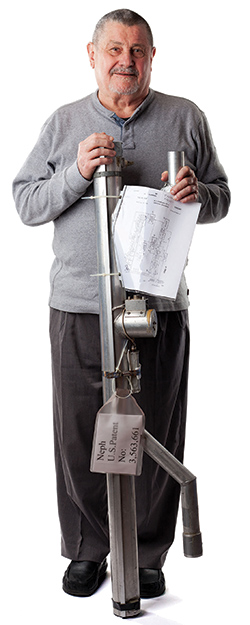Bob Charlson’s inquisitiveness led to UW’s first patent
Catching up with Robert Charlson, ’64, professor emeritus of Atmospheric Sciences and Chemistry, and co-inventor of the first UW-held patent that brought royalties to the UW.
 Standing on the deck of the oceanliner RMS Queen Elizabeth in 1965, Bob Charlson and his bride were taking a belated honeymoon trip after a year in England, where Charlson studied as a Fulbright Scholar. He couldn’t stop staring at the haze in the sky over the North Atlantic Ocean.
Standing on the deck of the oceanliner RMS Queen Elizabeth in 1965, Bob Charlson and his bride were taking a belated honeymoon trip after a year in England, where Charlson studied as a Fulbright Scholar. He couldn’t stop staring at the haze in the sky over the North Atlantic Ocean.
“I asked myself over and over, ‘why is it so hazy way out here in the middle of the ocean? It should be clean!’ ” recalls Charlson, who got his doctoral degree in atmospheric sciences from the UW. Little did he know that question would drive his research for the next 45 years.
Charlson is known worldwide among atmospheric scientists for his research into haze, or aerosols, the term used for the small particles in the atmosphere that affect climate and worsen lung conditions because they contain toxic and irritating pollutants like sulfuric acid.
“Man-made haze has helped cool the planet but it won’t solve global warming,” says Charlson, “considering that there are over 600 coal-fired power plants operating to this day in the U.S. In China, they are opening a new coal power plant every week or so.” Burning coal is the largest single source of carbon dioxide, which is a so-called “longlived greenhouse gas.”
When global warming research intensified 30 years or so ago, Charlson’s work began to be appreciated. To measure aerosols and their effect on climate, he invented an instrument called the integrating nephelometer (above). It was the first UW patent to generate royalties.
He started thinking about inventing as an undergraduate at Stanford. “One of my jobs was to fetch liquid nitrogen from a big tank in the physics department. To get there, I had to walk past all of these glass cases holding prototypes of the inventions of the klystron tube (think radar and microwave ovens) with little handwritten cards explaining them. I began to think about invention and to see myself as someone who could develop ideas.”
Today, the UW processes about 200 patent applications every year. Charlson would like to create a place on campus to showcase the many inventions that have come out of the UW, such as the shunt that made kidney dialysis available to the masses; the groundbreaking work on protein expression in yeast that led to a Hepatitis B vaccine; and dozens more.
One delicious result of UW research is that we can eat plump, succulent oysters in the summer. UW researchers introduced a condition called polyploidy, which means that farmed oysters no longer need to have a specific spawning season.